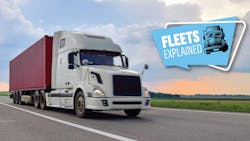Fleets Explained: How do trucking labor unions impact the freight industries?
Key takeaways
- Trucking unions have shaped driver pay, safety, and working conditions for over a century.
- Strikes remain a powerful tool for drivers to demand fair wages and benefits.
- Union membership is lower today, but major groups like Teamsters still influence trucking.
Labor Day was created to honor the American Labor Movement and the past and continuing contributions of laborers to the U.S. In honor of this year’s Labor Day (September 1, 2025), we’ll be taking a look back at the history of unions in the trucking industry and the industry’s union status today.
Since 1901, unions have represented drivers’ interests within the transportation industry, long before semitrucks became the most efficient way to move freight. While often at odds with carrier management and other business leaders, these organized labor groups have played a significant role in shaping the modern trucking industry.
History of trucking unions and driver strikes in the U.S.
The first trucking union in the U.S. was established in 1901: the Team Drivers International Union (TDIU). This union was formed to combat low pay and subpar working conditions for drivers. TDIU members divided in 1903, and some ex-members formed one of the biggest trucking unions still active today: The International Brotherhood of Teamsters (IBT).
The original TDIU and Teamsters represented drivers of horse-drawn carriages. As transportation in the U.S. advanced, the members expanded to include gravel haulers, beer wagon drivers, milk wagon drivers, bakery deliverymen, and, eventually, truck drivers, according to the IBT.
Historically, trucking unions dealt with issues regarding labor legislation, civil rights, driver wages, working conditions, job creation, women’s rights, safety, and more.
All unions, including those in the trucking industry, are possibly most known for their strikes. Strikes are used to pressure employers to provide better pay, working conditions, and benefits for their employees. Unions often play a big part in organizing these strikes.
Here are some of the significant trucking strikes throughout history:
- 1934: The Minneapolis general strike started when Teamster truck drivers walked off the job to demand better wages and union recognition, bringing much of the city’s trucking operations to a halt. On July 20, police shot into a crowd of unarmed strikers, killing two and injuring dozens of drivers in a confrontation that marked one of the most violent episodes in labor history. The strike ultimately led to successful unionization efforts for over-the-road drivers and helped establish the Teamsters as a major force in trucking.
- 1970s: Owner-operators (O/O) went on strike in the ‘70s to protest high fuel prices, along with other issues such as limited fuel supplies and a proposed national speed limit. The strikes began in late 1973 when one truck driver blocked Interstate 80 in Pennsylvania. Association-organized protests, including the Owner-Operator Independent Drivers Association (OOIDA), continued until an agreement was reached in early 1974. The agreement allowed O/Os to add a temporary 6% fuel surcharge to their freight fees and guaranteed that truck stops would receive additional fuel.
- 1994: This 24-day Teamsters protest was the union’s longest national trucking strike. The dispute occurred over a proposed contract from Trucking Management Inc. (TMI) that would have allowed for more part-time workers and rail transport. Teamsters feared this contract would take jobs away from truck drivers and cost them pay and benefits. The strike involved over 75,000 Teamsters and affected 18% of freight in the U.S. A compromise was reached after 24 days.
See also: Can you name the iconic Hollywood movies featuring these trucks?
The pros and cons of trucking unions for drivers and fleets
There are two ways drivers can join a trucking union: seek employment at a union company or organize their current workplace. Unions offer certain benefits to drivers but not every truck driver wants to be part of a union. Before joining, it’s important to know the general pros and cons.
Pros of unions for truck drivers
- Bargaining power: The biggest pro of being a part of a trucking union is strength in numbers. Instead of acting as a solo agent or even with fellow drivers part of a fleet, drivers have an entire organization behind them to help address concerns, negotiate with employers, fight for drivers' rights, etc.
- Job security: Unions often negotiate for contracts that allow for more stable employment. This can include seniority and recall rights.
- Pay and benefits: Instead of fighting for their own raise and better benefits, a union can fight on the truck drivers’ behalf.
- Opportunities: As part of the benefits of joining a union, most offer training and development opportunities to enhance skills and even gain certifications.
Cons of unions for truck drivers
- Fees: Union membership is not free. Members must pay membership dues regularly.
- Rules: Like any organization, unions have their own membership rules. There’s always the potential for members to disagree with a rule or find it overly restrictive.
- Strikes: Though strikes are a protected form of protest, members may experience financial or operational struggles during one.
- Internal politics: When belonging to a union, there’s always the potential for disagreeing with a specific union leader or decision. Not everyone wants to be swept up in these disputes.
Pros of unions for fleets
- Lower turnover: In theory, union benefits should create happy truck drivers, which means fleets have less driver turnover to worry about.
- Compliance assistance: Unions can help fleets navigate labor laws and stay in compliance.
- Improved driver relations: With a union agreement in place, fleets can have clearer relationships with their drivers and possibly less conflict.
Cons of unions for fleets
- Increased costs: Union contracts can lead to higher labor costs for fleets.
- Strikes: Just as strikes can lead to financial and operational struggles for truck drivers, the same goes for fleets if those drivers are striking instead of working.
- Reduced flexibility: With a union contract in place, fleets can’t make operational changes as quickly and easily as non-union fleets.
The current state of trucking unions in the U.S.
The state of U.S. trucking unions has changed significantly since the early 20th century. According to the U.S. Bureau of Labor Statistics in 2019, only 19% of for-hire drivers were unionized; only 17%of private fleet drivers belong to a union.
Major unions still exist, but the perception of trucking unions within the industry has declined due to fears of corruption and ineffective leadership, skepticism over benefits, and the industry’s overall political leanings. Trucking’s deregulation in the 1980s also negatively impacted union and driver power compared to larger companies.
Here are the industry’s current major unions:
- Teamsters: Still the largest union in the trucking industry today, Teamsters has over 1.3 million members across the U.S. and Canada. The union’s goal is to help truck drivers “wrest their fair share from greedy corporations.” Teamsters also represents bus drivers, transit workers, law enforcement, municipal and county workers, and more.
- United Automobile Workers (UAW): This union primarily represents workers in the auto, aerospace, and agricultural implement industries, but does include some truck drivers. UAW has over 400,000 active members and 580,000 retired members across the U.S., Canada, and Puerto Rico. According to UAW, a majority of the union’s retired members remain active within the organization.
- United Steelworkers (USW): USW is “North America’s largest private-sector union.” The union has over 850,000 members, including mostly manufacturing industries such as steel, aluminum, glass, cement, etc. Some truck drivers are included in this union, especially those in the bulk trucking segment.
- Transport Workers Union of America (TWU): TWU represents more than 155,000 members across the airline, railroad, transit, utility sectors, etc. The union won’t contain any long-haul truck drivers, but it does have courier fleet members.
About the Author

Jenna Hume
Digital Editor
Digital Editor Jenna Hume joined FleetOwner in November of 2023 and previously worked as a writer in the gaming industry. She has a bachelor of fine arts degree in creative writing from Truman State University and a master of fine arts degree in writing from Lindenwood University. She is currently based in Missouri.
